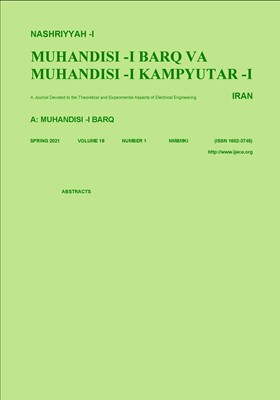Improving On-Off Current Ratio (Ion/Ioff) in Schottky-Barrier-Type Graphene Nanoribbon FETs
Subject Areas : مهندسی برق و کامپیوتر1 , Morteza Gholipour 2 * , 3
1 -
2 - Babol Noshirvani University of Technology
3 -
Abstract :
Schottky-barrier-type graphene nanoribbon transistors (SB-GNRFET), despite their prominent characteristics compared to conventional transistors, have a relatively high off-current and a low Ion/Ioff ratio. In this paper, a new structure of SB-GNRFET is presented in which the gate of the transistor is divided into two parts. A constant voltage is connected to the gate located on the drain side, and the gate located on the source side is the main gate of the transistor. The proposed SB-GNRFET is simulated using non-equilibrium Green functions-based numerical simulator under different geometric and physical characteristics and in biases. The simulation results show Ion/Ioff ratio improvement of up to 6.7-fold at VDS = 0.8 V. At this voltage the ratio has increased from 1.2 in the normal SB-GNRFET transistor to 8.01 in the new transistor and the off current has been reduced from 5 µA to 0.7 µA. Also at VDS = 0.6 V, as the supply voltage, the Ion/Ioff ratio increased from 3.97 to 15.8 and the off current decreased from 0.63 µA to 0.16 µA.
[1] Y. Wu, D. B. Farmer, F. Xia, and P. Avouris, "Graphene electronics: materials, devices, and circuits," in Proc. of the IEEE, vol. 101, no. 7, pp. 1620-1637, Jul. 2013.
[2] Z. Chen, Y. M. Lin, M. J. Rooks, and P. Avouris, "Graphene nano-ribbon electronics," Physica E: Low-Dimensional Systems and Nanostructures, vol. 40, no. 2, pp. 228-232, Dec. 2007.
[3] M. Zoghi, A. Yazdanpanah Goharrizi, and M. Saremi, "Band gap tuning of armchair graphene nanoribbons by using antidotes," J. of Electronic Materials, vol. 46, no. 1, pp. 340-346, Jan. 2017.
[4] A. C. Neto, F. Guinea, N. M. Peres, K. S. Novoselov, and A. K. Geim, "The electronic properties of graphene," Review of Modern Physics, vol. 81, no. 1, pp. 109-162, Jan. 2009.
[5] A. A. Balandin, et al., "Superior thermal conductivity of single-layer graphene," Nano Lett., vol. 8, no. 3, pp. 902-907, Feb. 2008.
[6] A. Yazdanpanah Goharrizi, M. Zoghi, and M. Saremi, "Armchair graphene nanoribbon resonant tunneling diodes using antidote and BN doping," IEEE Trans. on Electron Devices, vol. 63, no. 9, pp. 3761-3768, Sept. 2016.
[7] M. Saremi, M. Saremi, H. Niazi, and A. Yazdanpanah Goharrizi, "Modeling of lightly doped drain and source graphene nanoribbon field effect transistors," Superlattices and Microstructures, vol. 60, no. 1, pp. 67-72, Aug. 2013.
[8] Y. Y. Chen, et al., "A SPICE-compatible model of graphene nano-ribbon field-effect transistors enabling circuit-level delay and power analysis under process variation," in Proc. IEEE Design, Automation & Test in Europe Conf. & Exhibition, DATE’13, pp. 1789-1794, Grenoble, France, 18-22 Mar. 2013.
[9] M. Gholipour, Y. Y. Chen, A. Sangai, and D. Chen, "Highly accurate SPICE-compatible modeling for single-and double-gate GNRFETs with studies on technology scaling," in Proc. of the Conf. on Design, Automation & Test in Europe, 6 pp., Dresden, Germany, 24-28 Mar. 2014.
[10] Y. Y. Chen, A. Sangai, M. Gholipour, and D. Chen, "Schottky-barrier-type graphene nano-ribbon field-effect transistors: a study on compact modeling, process variation, and circuit performance," in Proc. of the IEEE/ACM Int. Symp. on Nanoscale Architectures, pp. 82-88, Brooklyn, NY, USA, 15-17 Jul. 2013.
[11] M. Gholipour, Y. Y. Chen, A. Sangai, N. Masoumi, and D. Chen, "Analytical SPICE-compatible model of Schottky-barrier-type GNRFETs with performance analysis," IEEE Trans. on VLSI Systems, vol. 24, no. 2, pp. 650-663, Feb. 2016.
[12] M. Gholipour, N. Masoumi, Y. Y. C. Chen, D. Chen, and M. Pourfath, "Asymmetric gate Schottky-barrier graphene nanoribbon FETs for low-power design," IEEE Trans. on Electron Devices, vol. 61, no. 12, pp. 4000-4006, Dec. 2014.
[13] M. B. Nasrollahnejad and P. Keshavarzi, "Inverse stone throwers wales defect and enhancing ION/IOFF ratio and subthreshold swing of GNR transistors," The European Physical J. Applied Physics, vol. 86, no. 2, Article No.: 20202, 14 pp., May 2019..
[14] P. Michetti and G. Iannaccone, "Analytical model of one-dimensional carbon-based schottky-barrier transistors," IEEE Trans. on Electron Devices, vol. 57, no. 7, pp. 1616-1625, Jul. 2010.
[15] B. Streetman and S. Banerjee, Solid State Electronic Devices, 6th Ed., Upper Saddle River, N.J.: Pearson/Prentice Hall, 2006.
[16] N. H. Frank and L. A. Young, "Transmission of electrons through potential barriers," Phys. Rev., pp. 80-86, Jul. 1931.
[17] H. S. P. Wong and D. Akinwande, Carbon Nanotube and Graphene Device Physics, Cambridge University Press, 2011.
[18] Y. Taur and T. H. Ning, Fundamentals of Modern VLSI Devices, Cambridge University Press, 2013.
[19] -, NanoTCAD ViDES, Accessed on Mar. 2019. [Online]. Available: http://vides.nanotcad.com/vides.
[20] S. Datta, Quantum Transport, Atom to Transistor, Cambridge University Press, USA, 2005.

